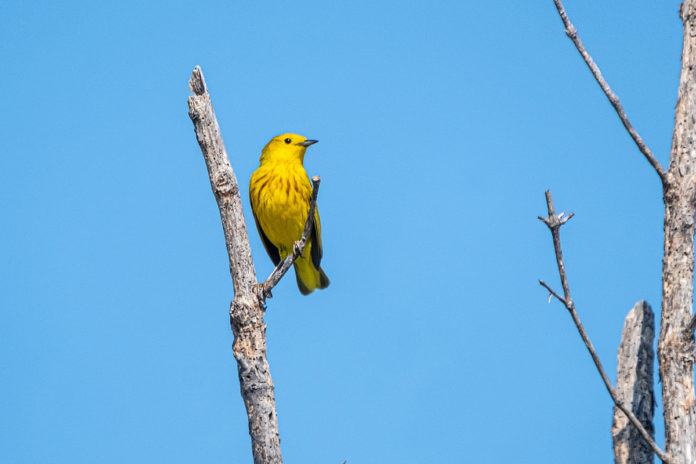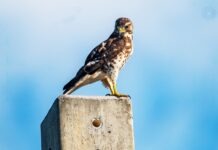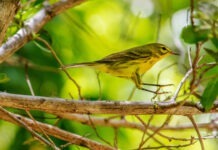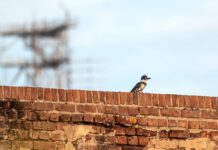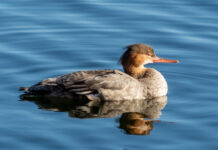Mnemonics are mental hacks designed to help us remember things. ROY G BIV. Every Good Boy Does Fine. King Phillip Came Over For Great Spaghetti. SPLUNGE*.
Bird books are full of mnemonics and written descriptions to help explain the complicated realm of bird songs. Some are so close to the mark and so deeply ingrained in the culture we don’t even question them – the quack of a duck, the caw of a crow.
Some birds, such as chickadees and Chuck-will’s-widows, are actually named for how their call (sort of) sounds.
Other mnemonics, though, can stray pretty far afield. The barred owl is supposed to say who cooks for you. The olive-sided flycatcher? Quick, three beers. The mnemonic for the black-throated blue warbler’s call is given alternately as zur-zur-zur-zree and please please please squeeeeze I am so laz-eeeeee. Further failing the playground snigger test is the warbling vireo, which allegedly sings, if I see you I will seize you and I’ll squeeze you till you squirt.
The thing about mnemonics is they generally work as cognitive retrofits. I mean, if you’ve somehow never heard a duck quack, you might be able to read the word quack, then hear a duck quack and connect the sound to the bird, but things don’t work that way 99.999% of the time.
You’ve got to hear the song first, connect it mentally to the bird, and then somehow attach the mnemonic to it.
With human music, it’s nearly impossible to hear a song’s melody just by reading the lyrics. But if you’ve heard the song before, any time you read, “Never gonna give you up / Never gonna let you down / Never gonna run around and desert you,” you can hear the melody, know the singer and possibly even envision the video.**
It works kind of the same with bird songs.
The use of mnemonics is something of an outmoded intellectual technique, an old-school attempt to bridge the gap between text seen in a field guide and sounds heard in the field. (Some field guides try to do this by printing spectrograms, though they’re not easy to wrap your brain around, either.)
Knowing some mnemonics will no doubt make you a better birdwatcher, but technology has rendered them less essential. A few taps on a smartphone will produce an accurate bird call.
Conversely, an app called Merlin can analyze a bird call and tell you what it is. (I’ve never used Merlin, and some birders say the app is often wrong, though that’s bound to get better over time.)
All this talk of mnemonics – and I swear that’s the last time I will use the word in this column – is a long walk to get to the fact that I heard a bird singing the other day on Geiger Key. I immediately thought sweet sweet sweetsweetsweet, which is one of the ways to remember the song of a yellow warbler. (Another version is sweet sweet I’m so sweet, but I prefer not to think of them as vain.)
Two warbler species breed, and therefore sing, in the Florida Keys – the prairie warbler and the yellow warbler. Both birds are primarily yellow, though the prairie has some black markings and the yellow has some red markings.
The prairie warbler is far more common. Its call is a rising series of quickening notes, as if climbing a traditional music scale a half-step at a time. You can hear a prairie pretty much anywhere, though slightly less often since Hurricane Irma. You’ll rarely hear the yellow warbler in the mainline Keys. They tend to like the out islands and very-out-of-the-way places.
This bird was singing in the top of a black mangrove next to a very well-traveled road. I managed to get binoculars on it, take a few still shots, then get some video of it singing. (View it at markhedden.com/notes).
He must have been foraging at the same time, because at first he was singing with a gob of spider web stuck to the side of his mouth. It made me laugh out loud while standing there by myself on the side of the road.
The breeding population in the Florida Keys also deserves an asterisk. While yellow warblers breed commonly across the U.S., the Keys are about 500 miles south of the next breeding population. But they also breed in Cuba. And the Cuban and Keys birds look different than the ones you see in, say, South Carolina or Minnesota. The males have small red caps that you can see when they angle their heads the right way.
A lot of birders will call them Cuban yellow warblers, and many believe they eventually will be considered a different species than their more northerly relatives. It’s a long and complicated discussion that cured my insomnia the other night.
In that roadside moment, though, I managed to push away any complicated thoughts about where the bird fit into the evolutionary tree.
I just watched and listened to it, this small yellow thing singing its fool head off against a clear blue sky.
It was sweet. Sweet sweet sweetsweetsweet.
* Fine. SPLUNGE isn’t a mnemonic. It’s a joke from an obscure Monty Python skit that I’ve been trying to slip into conversation on a regular basis since 1983.
** And yes. You just got Rick-rolled in a birdwatching column.















